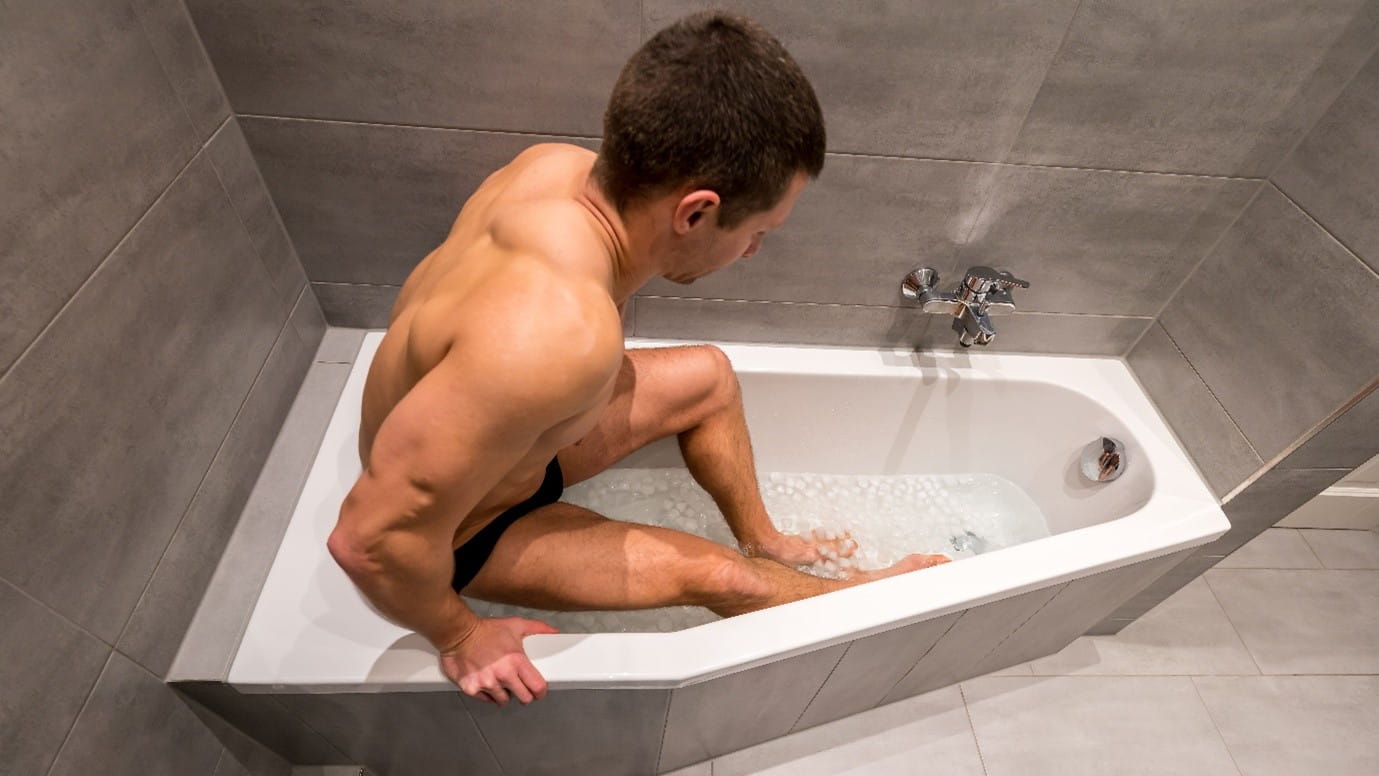Working out regularly is essential for enhancing health and wellness, but it can leave you feeling sore, exhausted, and in need of recovery. So what is the best way to recover? One highly effective method, adopted by athletes and health enthusiasts alike is taking an ice bath after a workout.
In this article, we’ll explore what an ice bath is, how it benefits post-workout recovery, how to prepare one, and how to implement it safely. With this knowledge, you can expect a faster and more effective recovery. Let’s get started!
What is an Ice Bath?
An ice bath is a form of cryotherapy – the use of extreme cold to stimulate the ‘fight or flight’ response. This treatment is used for a variety of health-related conditions as it naturally triggers physical and mental reactions. But don’t worry, you don’t need a specific reason to participate in cold therapy.
To setup an ice bath, all you need is a tub, fresh water, and ice. There are many different forms of ice baths, including standard ice baths, portable ice baths, DIY freezer ice baths, and cold plunge pools. By fully submerging your body in the ice-water mixture, you can activate the release of brain chemicals and stimulate vasoconstriction. Individuals looking to get the most out of cold-water immersion typically use ice baths a few times per week.
Benefits of Ice Baths After a Workout
Ice baths are a great way to enhance the physical and mental rewards of exercise. Here are the benefits of ice baths after a workout:
Faster muscle recovery
After an intense workout, your muscles require time to replenish and recover. Interestingly, ice baths speed up and improve recoverability in several ways. Cold exposure causes blood vessels to contract, which is where blood flow is slowed. This causes a decrease in inflammation, which is beneficial for faster muscle recovery.
Upon exiting the ice bath, your blood vessels will dilate due to better temperature regulation. Consequently, you’ll experience improved blood flow that helps take your muscles from a contracted state (caused by exercise and cold exposure) to a relaxed state. This is incredibly beneficial for recovery times, as it improves oxygen and nutrients delivery to the muscles. A secondary benefit is improved quality of sleep, which is a necessary component of recovery.
Reduces muscle soreness
Research found that cold-water immersion reduces muscle soreness by 20%, making it highly recommended for individuals in an ‘elite sporting environment’. Hey, if that’s what the research paper said, then it doesn’t mean you can’t benefit from it either. Anybody can expect reduced fatigue and pain by implementing an ice bath after their workout.
This pain relief occurs through the release of endorphins, turning off nerve endings, and vasoconstriction. Endorphins are chemicals in the brain that act to relieve pain by inhibiting the transmission of pain signals. Cold exposure also numbs these transmissions. Vasoconstriction limits the delivery of inflammatory cells, reducing inflammation and muscle soreness along with it.
Enhances mental resilience
Mental resilience is your willpower to overcome challenges, something that everybody can benefit from in their day-to-day life. Workouts are already great at increasing mental resilience, but finishing off the session with a cold plunge takes it a step further.
Exposing your body to extreme temperatures causes endorphins to release in the brain. This is know as the ‘feel good’ hormone, as helps relieve pain and reduce stress. Endorphins contribute to a greater sense of well-being.
Secondly, stressing your body increases cortisol production. This is a natural stress response that increases glucose in the bloodstream. To put simply, it support cognitive function, makes you more attentive, and more capable of handling hardships.
Improves flexibility and mobility
Workout sessions can you leave you feeling stiff, mainly due to lactic acid buildup and inflammation. This is a natural bodily response to repair muscles fibres that were damaged through strenuous actions (Ask the gym bro if you have any questions!) All jokes aside, ice baths can reduce these effects whilst still ensuring effective muscle recovery.
Ice baths improve flexibility and mobility by restricting blood flow to the extremities. This blood circulation is necessary for inflammation, as it is used to transport inflammatory cells. Through cold-water immersion, you can reduce muscle and tendon tension, making you quicker on your feet and positively impacting your flexibility and mobility.
How to Prepare an Ice Bath

If done correctly, preparing an ice bath can take less than 10 minutes. This can be perfectly integrated into your post-workout routine as it gives you enough time to partially regain your energy from the workout session. Here are 7 steps to successfully prepare your ice bath:
- Gather your equipment: You’ll require a tub, fresh water, ice, and a towel.
- Clean the tub: Give the bath a quick rinse down with fresh water or perform a deep clean with a soft detergent and a scrubber.
- Plug the tub: Use a dedicated plug to prevent drainage.
- Fill with fresh water: Fill up the tub one-third to halfway with fresh water, enough for full body submersion.
- Pour ice into the water: Determine the required ice for your ice bath and empty it into the water.
- Gently stir: Stir the ice-water mixture with a pole or your hand in a figure-eight motion.
- Monitor water temperature: Use a water thermometer to gauge the temperature, and add ice or water to reach your desired water temperature.
How to Safely Use an Ice Bath After a Workout
Voluntarily exposing yourself to near-freezing temperatures is no walk in the park. The experience can be physically challenging, especially after completing some hard sets at the gym. Here’s how you can use an ice bath safely after your workout:
- Stay hydrated: Drink plenty of water as it helps regulate body temperature.
- Shower before entering: Don’t introduce unnecessary sweat or bacteria that can contribute to illness and infection.
- Test the water: Monitor water temperature and submerge feet first. You should feel a light shock as you enter but not significant discomfort.
- Use a timer: As a beginner, you should not submerge for more than 3 minutes. As your body adapts to the cold, you’ll be able to withstand it for longer periods.
- Listen to your body: Exit the ice bath if you experience pain, difficulty breathing, or nauseousness.
- Warm up slowly: Use natural methods to warm up gradually: clothing and blankets, warm drinks, sunbathing, sauna, or massage to name a few.
Conclusion
Adding an ice bath to your post-workout routine is no doubt, a great decision. It will enhance muscle recovery, improve mental resilience, detoxify the body, while also boosting flexibility and mobility. This makes it effective at optimising the health benefits of working out.
We also provided the necessary steps to prepare your ice bath and how to use it safely after a workout. This way, you can easily integrate it into your health journey. Embrace the cold and experience the benefits for yourself!







